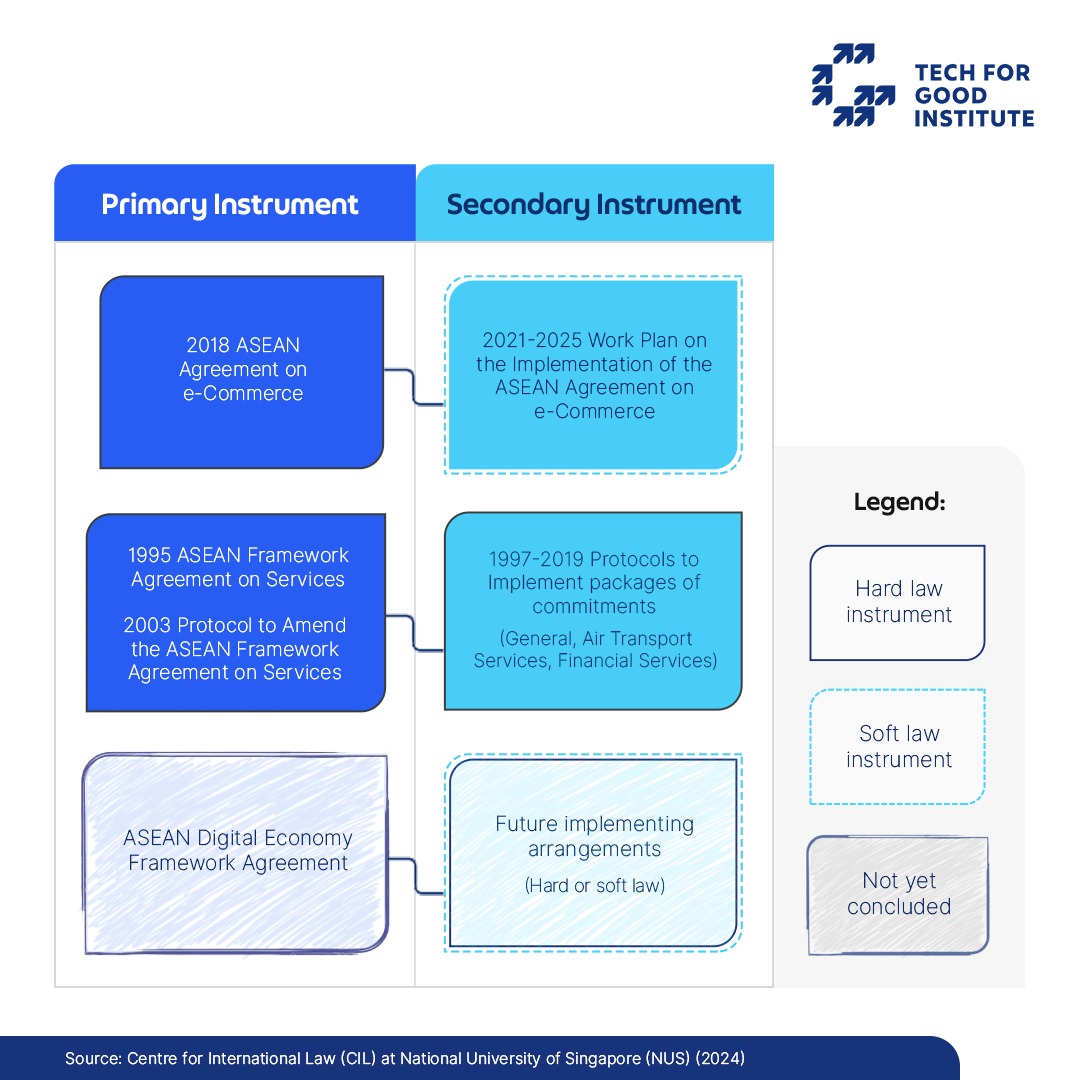
By Dr Tan Hsien-Li. Assistant Professor at the Law Faculty; and Co-Director of the ASEAN Law and Policy Programme at the Centre for International Law (CIL) at National University of Singapore (NUS), Chan Sze-Wei, Research Associate in the ASEAN Law and Policy Programme at CIL, NUS and Ms Yvette Foo, Research Assistant in the ASEAN Law and Policy Programme at CIL, NUS.
Since the advent of the internet and the advancement of digital technology, ASEAN and its member states, like elsewhere in the world, have endeavoured to enhance their digital capabilities. Following the adoption of the e-ASEAN Framework Agreement in 2000, ASEAN members have entered into various agreements, including soft laws (non-binding instruments) such as the ASEAN Digital Integration Framework (2018) and hard laws (binding treaties) such as the ASEAN e-Commerce Agreement (2019). These agreements aim to improve connectivity and affordable access to ASEAN people and businesses, modernise the region’s financial and business ecosystems to enhance commerce and trade, and accelerate ASEAN’s workforce transformation. The need to intensify ASEAN’s digital progress across multiple sectors has become even more urgent during the COVID-19 pandemic, where digital technology was imperative for education, business, industry, and government to continue functioning despite physical lockdowns and restrictions. Notably, the ASEAN Digital (Information and Communications Technology) Ministers adopted the ASEAN Digital Masterplan 2025 in January 2021, and the ASEAN Economic Ministers adopted the Bandar Seri Begawan Roadmap: (BSB Roadmap) in November 2021 to intensify ASEAN’s digital transformation.

Wide-ranging digital transformation efforts across diverse ASEAN sectoral bodies, including e-commerce, customs, trade facilitation, intellectual property, consumer protection, banking, and digital communications, have led member states to recognise that a coherent strategy transcending organisational silos is vital for ASEAN’s post-COVID-19 recovery and long-term competitiveness. Given that digital economic integration increasingly impacts ASEAN economies and societies, and in fulfilment of the final provision of the BSB Roadmap, ASEAN members began negotiating the DEFA in December 2023, with a hoped-for conclusion by 2025. When adopted, apart from ostensibly being the world’s first binding regional treaty on the digital economy, DEFA is meant to outline the comprehensive obligations that members will need to cooperate on over the short, medium, and long term for ASEAN’s digital transformation and digital economic integration. The Framework for Negotiating the ASEAN Digital Economy Framework Agreement (the Negotiating Framework) and ASEAN’s long standing cooperation in the economic and digital sectors illuminate the possible contours of DEFA’s (1) substance, (2) legal design, and (3) compliance.
DEFA’s Substance Contextualised Against ASEAN’s Multisectoral Digital Environment
The Negotiating Framework states that, on a ‘without prejudice’ basis, DEFA negotiations will focus primarily on (but are not limited to) nine areas, namely: (1) trade facilitation through electronic documents and operations, (2) creating a fairer and more efficient arena for e-commerce, including digital goods and services, (3) promoting and regulating digital invoicing and payments, and (4) developing a mutually recognisable and interoperable digital identity and electronic authentication framework for the region, (5) strengthening online safety and cybersecurity, (6) improving data protection and privacy, (7) promoting and enforcing a transparent environment for business competition and consumer choice, (8) regulatory cooperation to keep up with technological innovations in emerging topics such as artificial intelligence, and (9) enabling digital talent mobility in the region and cooperating on digital talent-building. As these areas have been endorsed without prejudice, there is room for divergence in the final agreement. Additional areas of coverage could include fintech, digital workforce upskilling, or intellectual property.
It is important to note that while DEFA is a treaty endorsed by the ASEAN heads of state and government and spearheaded by the ASEAN Economic Community, DEFA will not override or detract from existing rights and obligations under other digital agreements in other ASEAN sectors. DEFA is meant to complement and cohere with other ASEAN digital initiatives. In fact, the work undertaken by DEFA dovetails closely with what the ASEAN Digital Sector is doing, particularly the goals of the ASEAN Digital Masterplan. Notable examples include the ASEAN Digital Sector’s launch of the EU-ASEAN Joint Guide on Model Contractual Clauses for International Data Transfers that aims at aiding businesses of all sizes to negotiate contracts on cross-border data flows more easily, the focus on artificial intelligence governance in industry, digital infrastructure and skills with respect to foreign investment, expanding digital connectivity and supply chains across ASEAN markets, and combating scams and cybercrime.
DEFA’s Legal Design in ASEAN’s Rules-based Order
DEFA calls for a ‘rules-based’ approach to digital cooperation in the region. Therefore, a brief exposition on how ASEAN’s rules-based order operates — thus laying out ASEAN law-making, the types of ASEAN instruments that exist, their nomenclature, and how they are used — is key to understanding DEFA’s legal design and reach as a ‘Framework Agreement’.
To begin, ASEAN’s rules-based order has developed a longstanding system of primary and secondary legal instruments, of both hard and soft legal natures, to set its economic, security, and socio-cultural community agendas. Notably, ASEAN law-making practice does not require primary and secondary laws to be legally binding — both hard and soft laws are acceptable, and compliance is expected of both types. Generally, hard legal instruments in ASEAN often bear the nomenclature of ‘treaty’ or ‘agreement’ and hold legally binding obligations that are subject to dispute settlement proceedings. Simply put, breaches are litigable. (It is important to highlight that as ASEAN values inter-member amicability, intraregional dispute settlement mechanisms have not yet been used.) In contrast, soft legal instruments in ASEAN are non-binding, thus are non-litigable. However, adherence to soft law commitments is nonetheless strongly expected. ASEAN soft laws may come in the form of ‘declaration’ and ‘concord’. Very often, serious soft legal commitments come in time-limited instruments such as ‘masterplans’, ‘roadmaps’, ‘blueprints’, and ‘workplans’ (as seen in the ASEAN Digital Masterplan and BSB Roadmap).
This system of primary and secondary hard and soft laws works in two main ways in ASEAN’s rules-based order. First, primary hard law instruments are often used in setting major overarching economic agendas such as, for example, the ASEAN Agreement on Electronic Commerce. (Adoption of primary hard laws is rarer for ASEAN’s political-security and socio-cultural goals.) The primary law is usually followed by secondary laws that elaborate commitments in greater detail; in this instance, the Work Plan on the Implementation of ASEAN Agreement on Electronic Commerce is the accompanying secondary soft law. Another instance is that both the primary law and the secondary ones are of a hard legal nature. A good example of this is how the ASEAN Framework Agreement for Services is accompanied by supplementary protocols comprising independently negotiated packages of sectoral-specific commitments. The second way of usage is that ASEAN members use primary soft law instruments to articulate more sensitive, complex, or resource-intensive ambitions in the security, socio-economic, and developmental arenas. These are then elaborated by secondary soft laws that have more open-ended wording because some default is foreseeable due to the long-term attainment of these aims. A prominent example is seen in the ASEAN human rights arena where the primary instruments such as the ASEAN Human Rights Declaration and Terms of Reference of the ASEAN Intergovernmental Commission on Human Rights (AICHR) are accompanied by the secondary soft law, the five-year AICHR Work Plan.
Against this backdrop of ASEAN’s rules-based order, DEFA can now be better understood. DEFA’s nomenclature as a ‘Framework Agreement’ indicates that it will be a primary hard law instrument — that is, a treaty with binding legal obligations and will have dispute settlement provisions — that articulates ASEAN’s overarching aims for digital economic integration. In line with ASEAN’s usual treaty-making practice, once DEFA is signed, it will enter into force once a certain number of members ratify it or complete their national procedures to incorporate DEFA. Recognising that DEFA covers nine complex issue-areas of digital economic integration that are constantly evolving and expanding, and the ten ASEAN members span different levels of economic development and digital capability, DEFA obligations could be elaborated in secondary hard laws such as protocols or secondary soft laws such as time-limited workplans. Either way allows the mammoth steps needed for ASEAN’s digital integration to be implemented in phases. As such, DEFA can be a ‘dynamic’ agreement that expands to encompass technological innovation or new areas of digital cooperation through future secondary instruments. Given the digital disparity among ASEAN members, it is possible (perhaps even likely) that DEFA and its secondary instruments could expressly allow less developed members a longer timeline for fulfilling commitments (in accordance with the ‘ASEAN Minus X’ formula for staggered implementation of ASEAN economic commitments). DEFA may even have clauses or secondary instruments that support the development of these members’ digital infrastructure.
In crafting DEFA and its workplans and visions, ASEAN should be mindful of lessons learned from the large-scale, cross-sectoral project on ASEAN connectivity. ASEAN connectivity initiatives took time to find focus, first through the Master Plan on ASEAN Connectivity (MPAC, 2010), then its successor, the MPAC 2025. These soft law instruments identified the connectivity challenges ASEAN should address but comprehensive resource constraints continue to impede how ASEAN as an organisation can realistically contribute to region-wide infrastructure development, facilitate supply chain and logistical connectivity, and establish regulatory frameworks. It is unclear whether the adoption of a hard law instrument like DEFA will result in a different outcome, or if it will encounter similar teething problems, since both instruments deal with similar cross-sectoral complexities.
The views and recommendations expressed in this article are solely of the author/s and do not necessarily reflect the views and position of the Tech for Good Institute.
Keep an eye out for the second part of this series, where we delve into Ensuring Compliance with DEFA in ASEAN’s Rules-based Order and its recommendations.
About the writers
Dr Tan Hsien-Li is Assistant Professor at the Law Faculty; and Co-Director of the ASEAN Law and Policy Programme at the Centre for International Law (CIL) at National University of Singapore (NUS).
Chan Sze-Wei is a Research Associate in the ASEAN Law and Policy Programme at CIL, NUS. Sze-Wei’s research focuses on the development of ASEAN institutions and legal frameworks, and is a continuation of their involvement in the ASEAN Charter drafting process from 2006-2007 while working in the Singapore Foreign Service.
Ms Yvette Foo is a Research Assistant in the ASEAN Law and Policy Programme at CIL, NUS, and Assistant Production Manager for the Asian Journal of International Law. She is researching ASEAN economic integration and dispute settlement mechanisms.



